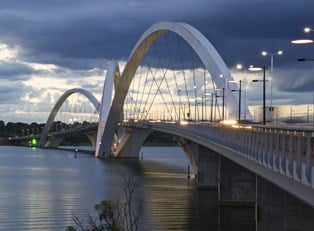São Paulo, the largest city in Brazil, is located on the Southern coast in in the Brazilian Highlands. The metropolitan part of the city is home to nearly 20 million people, and nearly 30 million when taking in to account the outlying suburban area. The city is named after Saint Paul of Tarsus, a reflection of the religious leanings of the population, with 60% of residents identifying themselves as Catholic and 30% identifying as Protestant. The weather in São Paulo is infamous for being unpredictable, and many locals refer to the city as the "City of Drizzle". Like most of Brazil, Paulistanos, or those who reside in São Paulo, speak Portuguese.
The History of São Paulo
São Paulo was founded in 1554 by 12 Jesuits who wanted to spread their religion to the local tribes. The priests founded the Patio do Colegio, a school and church, to reach the locals. Shortly after Brazil declared independence from Portugal in 1823, São Paulo was named an Imperial City. As such, a law school and university were established. The exportation of coffee from the São Paulo funded the local economy, and in 1932, a protest arose in São Paulo against the federal government. Fighting lasted approximately 87 days and the city has a memorial to honor those who died in the uprising.
Popular Sites in São Paulo
Due to its size and the rich history of the city, there are many historical and cultural landmarks to see in the city. Paulista Avenue is one of the main streets in the city, and is home to many cultural landmarks. Among the most notable are the Centro Cultural Itau and the Sao Paulo Museum of Art (MASP).
São Paulo boasts several beautiful parks in the city. Ibirapuera Park is the second largest with an area just under a square mile and is most popular in the city, comparable to Central Park in New York. Within the park there are several museums, including the Museum of Modern Art (MAM) and Museum of Contemporary Art. The park also has jogging trails, a convention center, and a planetarium.
Culture of São Paulo
São Paulo is the industrial center of Brazil, but for its size is a very safe city. Sao Paulo reports a homicide rate less than half of Brazil's national homicide rate. Air quality is high in São Paulo and is continually getting better. The city has also enacted anti-pollution campaigns. Both of the rivers in the city are being cleaned as a result, in addition to the removal of thousands of billboards around the city.
Due to the size, São Paulo is the multicultural hub of Brazil, and is one of the most diverse cities in the world. The city has Asian and Italian districts, and has many fine Chinese and French restaurants. The city is the birthplace of many prominent Brazilian music composers, sports figures, and politicians, and is a perfect place to visit for both relaxation and cultural education.



